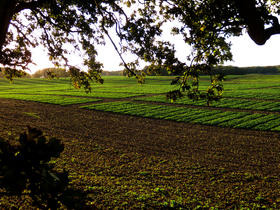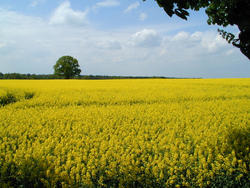Improvements in the classical plant breeding and the rapeseed breeding progress
The classical rapeseed breeding is completed by modern methods

The breeding progress gets clear
Oilseed rape breeding from the Rapool-partners is focused on three targets: Yield, Quality and Resistance. There is no other plant where the breeding on yield and quality is more successful than by oilseed rape. The breeding of oilseed rape has a long tradition and has made the oilseed rape plant into an important agricultural cultivar.
The adjustment to 0- or rather 00-oilseed rape enabled the oil and meal to be used for a wide range of purposes. Erucic acid from rapeseed played a secondary role worldwide but has turned into an important component for the production of detergents. The cultivation of the new ‘quality oilseed rape’ e.g. high oleic/low linolenic acid (HOLLi) increased to nearly 1 million hectares and an estimated annual increase of up to 10% is expected. The biggest customers of rapeseed oil are the biodiesel-industry and the fat chemistry. Rapeseed oil is a liquid, can be pumped and measured out, is storable and has got a high energy content. With these qualities it possesses the ideal requirements for the in energy industries and the mobile world in which we now live in.
For the breeders in the Rapool-Ring the varieties and yield are the center of the attention. Developments in the hybrid seed production process are fully optimized and yield increase by fertilisation and pest control can’t be expected in countries like Germany due to the environmental consciousness of the public. Yield increases must be achieved by improved genetics and therefore a large emphasis is placed on plant breeding.
Varieties and seed treatment promises for some big progress in the future and are distinctively obtainable in certified seeds. The production of certified seed is expensive and time consuming; therefore the sales of certified seed are important because a large proportion of the turnover is reinvested into breeding programs and development. This breeding intensity must be maintained to insure the long-term competitiveness of European farmers.
Hybrids - the future of the oilseed rape breeding

In the years to come oilseed rape breeding will produce new efficient hybrid varieties with high stable yields combined with very high oil contents. Improvements will also be made, using new gene pools, in the resistance against Clubroot (Plamodiophora brassicae) which will replace Mendel. Further advancements have been made with the inclusion of the RLM 7 gene against Phoma. Varieties with Verticillium tolerances are on the way. Early sowing and varieties with stable pods will increase the sowing and harvest window. The breeders will further focus on N-efficiency and drought tolerance.
There will be improvements in special qualities such as Erucic acid and HOLLI through the breeding of new hybrids. New ‘short’ hybrids with high yield potential are registered and in the next few years will compliment other varieties available. Varieties with herbicide resistance (Clearfield) are developed, which are based on classical breeding-methods, selected conventionally and bred without using genetic modification. These varieties may improve the weed control in countries such as Eastern Europe where the range of herbicides available is limited.
The worldwide demand of rapeseed oil and meal is increasing and the production must be adapted. Furthermore, the oilseed rape acreage will increase in areas with potential. In areas where the acreage cannot be increased, the breeding objective is to produce plants that have stabler and higher yields.
RAPOOL-RING GmbH, September 2011



